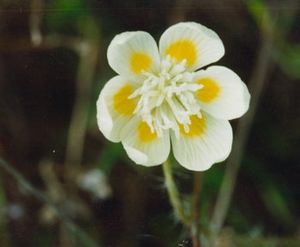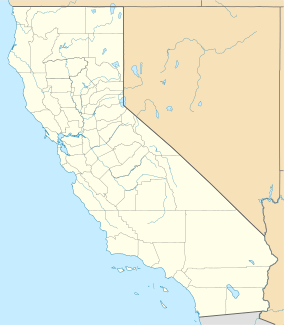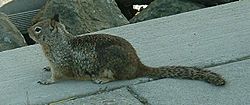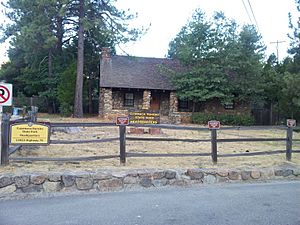Cuyamaca Rancho State Park facts for kids
Quick facts for kids Cuyamaca Rancho State Park |
|
|---|---|

The West Mesa Trail in Cuyamaca Rancho State Park
|
|
| Location | San Diego County, California, United States |
| Nearest city | San Diego, California |
| Area | 24,693 acres (99.93 km2) |
| Established | 1933 |
| Governing body | California Department of Parks and Recreation |
Cuyamaca Rancho State Park is a state park in California, United States, located 40 miles (64 km) east of San Diego in the Cuyamaca and Laguna Mountains of the Peninsular Ranges. The park's 26,000 acres (11,000 ha) feature pine, fir, and oak forests, with meadows and streams that exist due to the relatively high elevation of the area compared to its surroundings. The park includes 6,512-foot (1,985 m) Cuyamaca Peak, the second-highest point in San Diego County.
Park amenities include trails for hiking, horseback riding, and mountain biking, as well as campgrounds for family, group, equestrian, and primitive trail camping; as well as an exhibit at a former gold mine, the Stonewall Mine.
Wildlife in the area includes mountain lions, which have been known to attack humans, and park literature emphasizes avoiding encounters with them. Numerous other species of mammals, birds, reptiles, and amphibians are known to reside within the park.
The park was closed for several months due to massive damage incurred in the 2003 Cedar Fire. Although much of the forest was burned, the park has since been reopened and the fire ecology regenerating native plants are re-growing and returning.
Contents
Geology
Cuyamaca Rancho State Park is located in the Peninsular Range, which extends from the San Jacinto Mountains north of the park, southward to the tip of Baja California. At the western edge of the most seismically active area in North America, the range is a great uplifted plateau, cut off from the Colorado Desert to the east by the Elsinore Fault Zone, where vertical movement over the last two million years has amounted to thousands of feet of tectonic uplift.
Metamorphosed sediments such as schist, gneiss, and quartzite are abundant in the Cuyamacas, particularly in the Stonewall Mine area. Most of the rocks now seen in the park are plutonic: either the granodiorite comprising Stonewall Peak, or the gabbro comprising Cuyamaca Peak. As these bedrocks weather, they become the parent material of the coarse, acidic, red soil found throughout the area. Gabbro weathers to a darker red soil than granodiorite or other quartz-rich rock.
Gold is a natural element that appears around granite formations because gold forms during cooling and solidification of igneous rock. Gold commonly occurs in association with quartz, either as pure gold or as an ore. In the Cuyamaca area, gold is associated with the metasediment called Julian Schist. At mines in this area, including the Stonewall, veins of gold were followed into the bedrock and the surrounding ore excavated. Most streams in the park have small amounts of gold, since it is constantly being removed from the quartz exposures by weathering.
Flora
Trees
Cuyamaca's average elevation of nearly 5,000 feet (1,500 m) enables many conifers and broadleaf trees to exist; a rarity in xeric Southern California. The conifers include the white fir, incense cedar, Coulter pine, Jeffrey pine, sugar pine and ponderosa pine. The broadleaves include the white alder, Arizona ash, California sycamore, Fremont cottonwood, coast live oak, canyon live oak, Engelmann oak, California black oak, interior live oak, oracle oak, and red willow.
Shrubs
Large shrubs, those ranging from 4–15 feet (1.2–4.6 m), include chamise, Eastwood manzanita, Cuyamaca manzanita, Mexican manzanita, cupleaf mountain lilac, whitebark mountain lilac, Palmer mountain lilac, mountain mahogany, creek dogwood, Parish goldenbush, yerba santa, Parish burning bush, toyon, California barberry, laurel sumac, hollyleaf cherry, western chokecherry, scrub oak, coffeeberry, western azalea, white sage, and elderberry.
The park's smaller shrubs, ranging from 1–4 feet (0.30–1.22 m), include California buckwheat, Wright's buckwheat, chaparral honeysuckle, California rose, creeping sage, snowberry, and poison oak.
Wildflowers

| Early Season | Middle Season | Late Season |
|---|---|---|
| milkmaids (Cardamine californica) | purple nightshade (Solanum xanti) | penstemon (Penstemon spp.) |
| California peony (Paeonia californica) | monkeyflower (Mimulus spp.) | locoweed (Astragalus spp.) |
| goldfields (Lasthenia spp.) | mule's ears (Wyethia helenioides) | cudweed (Pseudognaphalium californicum) |
| creamcups (Platystemon californica) | milkweed (Asclepias spp.) | thistle (Cirsium occidentale) |
| checkerbloom (Sidalcea spp.) | wallflower (Erysimum spp.) | Indian paintbrush (Castilleja spp.) |
| splendid Mariposa lily (Calochortus splendens) | golden bowl Mariposa lily (Calochortus concolor) | California fuchsia (Epilobium canum) |
| tidytips (Layia spp.) | virgin's bower (Clematis lasiantha | goldenrod (Solidago spp.) |
| golden yarrow (Eriophyllum confertiflorum) | yarrow (Achillea millefolium) | |
| columbine (Aquilegia spp.) | Humboldt's lily (Lilium humboldtii ssp. ocellatum) | |
| baby blue eyes (Nemophila menziesii) | ||
| purple lupine (Lupinus polyphyllus) | ||
| goldenstars (Bloomeria crocea) |
Fauna
Frequently seen mammals in Cuyamaca Rancho State Park include the southern mule deer, coyote, California ground squirrel, Merriam's chipmunk, black-tailed jackrabbit, brush rabbit, and Audubon's cottontail rabbit. Cougars are present but rarely seen.
About 200 species of birds have been documented in the park. Several of the most commonly seen bird residents and migrants are the wild turkey, acorn woodpecker, Nuttall's woodpecker, northern flicker, Steller's jay, western bluebird, white-breasted nuthatch, mountain chickadee, oak titmouse, American robin, red-tailed hawk, and red-shouldered hawk. Migrants and summer residents include the black-headed grosbeak, Baltimore oriole, ash-throated flycatcher, western wood pewee, house wren, several warblers, and the lesser goldfinch.
Resident amphibians and reptiles include the canyon tree frog, Pacific tree frog, red-legged frog, western toad, common king snake, gopher snake, California mountain kingsnake, racer, striped racer, and western garter snake.
Park history
Historical features in Cuyamaca Rancho State Park date from prehistoric humans through the Southern California Gold Rush.
Native Americans
Indigenous peoples in the area date back a minimum of 7000 years. Traces of their ancient and pre-contact civilizations are within the park, which is a Cuyamaca complex archeological site. Early bedrock mortars mark the sites of summer camps and villages. Even the name "Cuyamaca" is a Spanish version of the name the native Kumeyaay peoples used for this place. In water-short Southern California, the native Americans called the area Ah-Ha Kwe-Ah Mac, meaning "the place where it rains."
Kumeyaay peoples' traditional lands range from San Diego east through the Cuyamaca and the Laguna Mountains through present day Anza-Borrego Desert State Park to beyond the Salton Sea in the east, and south beyond present day Ensenada, Baja California on the Baja California Peninsula in Mexico. A typical band's typical range was a 20-mile (30 km) radius from their winter home. Today twelve federally recognized Kumeyaay tribes are in San Diego County.
19th century
The park is located on the 1845 Rancho Cuyamaca Mexican land grant. With the discovery of gold in Julian in 1869, the Spanish, Mexican, and American governments and settlers changed the Kumeyaay's way of life forever. Disease spread through the Kumeyaay, traditional ways of life were destroyed, and promises broken as the Indians were expelled in 1875 from ancestral lands and taxed without representation. Currently there are about 20,000 Kumeyaay descendants in San Diego County, 10% of whom live on the 18 reservations which range from 6.3 to 122,000 acres (0.025 to 490 km2).
The Stonewall Mine opened in 1870 and started the boomtown of Cuyamaca City. Peak production at the mine occurred between 1886 and 1891 while employing over 200 workers. In 1889 Cuyamaca Dam was completed and in 1892 Stonewall Mine was permanently sealed after large losses.
20th century
In 1923 Ralph Dyar bought the Cuyamaca Rancho and built a summer home. In 1933 he sold his property to the state, thereby creating Cuyamaca Rancho State Park. Now the park is over 26,000 acres (105 km2) of protected wildlife habitat, watershed, archeological sites, botanical reserve, and recreational land with roughly half of the park classified as wilderness area.
Cuyamaca Rancho State Park Interpretive Association
The Cuyamaca Rancho State Park Interpretive Association (CRSPIA) supports the mission of Cuyamaca Rancho and Palomar Mountain State Parks through education and interpretive activities that enhance the visitor's experience. CRSPIA accomplishes its goals principally through fundraising and supporting interpretive programs. Support is also provided for the parks' volunteer groups, which include the Interpretive Assistance Unit, the Mounted Assistance Unit, the Mountain Bike Assistance Unit, and the Trails Maintenance Unit.
Historically CRSPIA has passed along to park programs more than 95% of all funds received from the public. Sources of funds include profits from the operation of a gift shop and bookstore, sale of firewood, membership dues, and various fundraising events. Over the last decade, revenues have grown steadily to the current level of approximately $40,000 per year. Members receive a monthly newspaper, The Stonewall Sentinel.
The extensive Cedar Fire of October 2003 in Cuyamaca Rancho State Park destroyed the park's museum, CRSPIA's gift shop, and bookstore along with the entire inventory. However a temporary facility has been constructed to house operations and provides these services once again to park visitors.






